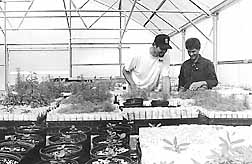![]()
![]()
![]()
![]()
![]()
![]()
![]()
Restoration activities at Miramar prove there is life after landfill.
provided by the City of San Diego Department of Environmental Services
![]() iramar Landfill's closed areas will soon look a lot
like they did before Miramar became the city's only trash disposal site:
natural open space. A large-scale revegetation project is underway on 150
acres of the Landfill's closed areas using high quality compost and native
plant species from the Landfill's new nursery. Without this effort, the
closed areas would be left with hills forever stripped and barren, covered
with "dead" infertile soil.
iramar Landfill's closed areas will soon look a lot
like they did before Miramar became the city's only trash disposal site:
natural open space. A large-scale revegetation project is underway on 150
acres of the Landfill's closed areas using high quality compost and native
plant species from the Landfill's new nursery. Without this effort, the
closed areas would be left with hills forever stripped and barren, covered
with "dead" infertile soil.
The revegetation starts with creating fertile
soil. Environmental Services staff are able to achieve two environmental
benefits at once by diverting green waste from landfill burial and recycling
it in a highly effective composting operation. The end result is a rich
soil that works as a slow-release fertilizer and helps to control erosion.
The compost is utilized in conjunction with a newly completed 2,500 square
foot nursery, currently housing nearly 18,000 native plants.
Compost is created by adding moisture and regularly
mixing - or aerating - green waste as it decomposes. This decomposition
generates high temperatures (130 degrees or more) that kills weed seeds
and disease organisms which are often present in green waste. This pilot
project at the Miramar Landfill is creating a high quality end product that
is producing excellent results in the landfill's new native plant nursery.
 Dept. of Environmental Services staff in the new 2,500
square foot nursery work with native plants destined for revegatation of
150 acres at the Miramar Landfill.
Dept. of Environmental Services staff in the new 2,500
square foot nursery work with native plants destined for revegatation of
150 acres at the Miramar Landfill.
The nursery, along with a 3,200 square foot
shade house under construction, is used to grow seedlings and cuttings of
native plant species for outplanting. The greenhouse, built by Environmental
Services staff, has automated water misting and a thermostat linked to ventilation
controls to ensure proper temperatures inside. Native plants cultivated
include California Sagebrush, Deerweed, Laurel Sumac, and Black Sage.
Environmental Services Department biologists
will be spreading the compost and planting the seedlings beginning this
month with the help of volunteers from local schools, environmental organizations
and probation crews. The plants will be randomly distributed and will fill
in over time to match surrounding natural areas.
Miramar Landfill covers 1,430 acres, portions
of which will continue to be used for trash disposal until approximately
the year 2011. The revegetation project, the final stage of responsible
environmental landfill protection, will be utilized to restore the natural
integrity of each area of the landfill as it is filled to capacity and closes.
Volunteers interested in participating in the
revegetation effort can donate their time to help restore the native plant
life at Miramar Landfill. Training on use of tools and planting protocol
is included. Call Burton Ewert for more information at 636-4834.